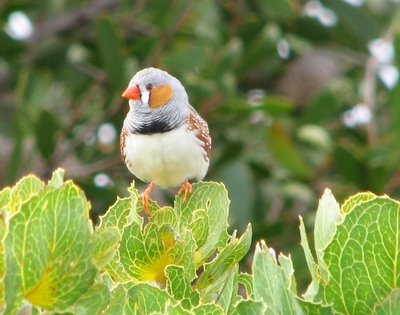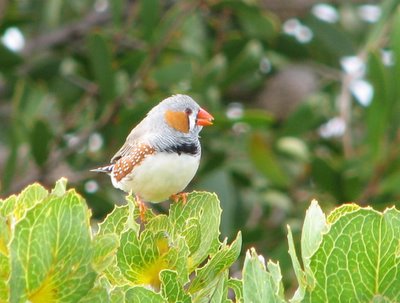Rock Doves
This posting sits a little uneasily. All postings are supposed to be about Australian birds. I am about to break my own rule and show some photos of an introduced species, the Rock Dove or Feral Pigeon. (It is also called a Domestic Pigeon or Homing Pigeon).

Above: Photo of Rock Doves perching on a dead
eucalyptus branch, near Murray Bridge, South Australia.
A few weeks ago I managed to get a good photo of two Rock Doves perched on the dead branches of a eucalyptus tree near our home. They allowed me to approach quite close before flying off. Many more were feeding on the ground in a nearby paddock.
In Australia, like so many places, they have become a pest species, especially in city parks and gardens. I have also seen large flocks numbering in the thousands along the coastal cliffs in parts of South Australia.
Rock Doves were introduced to Australia many years ago and have successfully spread throughout the more temperate regions of southern and eastern Australia. They have been particularly successful in our larger cities and towns. Very large flocks can also been seen near grain storage silos in rural areas.
Many cities around the world have a massive pigeon problem. The health risk posed by these birds must be enormous, not to mention the mess they make. On a recent visit to Kathmandu, Nepal, I had the misfortune to be the target of not one but two pigeons on the same day. This annoyance resulted in some extra washing in my hotel room that night. I was so pleased I was wearing a hat at the time.
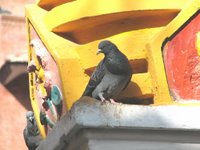
Above: A photo of a Rock Dove on a temple, Kathmandu, Nepal.
Several days later while visiting the city of Patan, Kathmandu, I saw a local lady selling food for tourists and locals to feed to the local population of pigeons. As the seed was spread by her customers, hundreds of pigeons descended from the nearby temples and other buildings in thick clouds of flapping feathers. They all assembled hurriedly in a little chained off area set aside for the purpose. This is not the way to discourage their booming populations. I didn’t stop to ask if feeding the pigeons had some religious significance; perhaps it did.
Spiny Cheeked Honeyeaters
Above: A photo of a Spiny Cheeked Honeyeater.
Spiny Cheeked Honeyeaters are a resident breeding species in our garden in Murray Bridge, South Australia. While they are not very common or numerous in this area they are widespread. They tend to be found in the drier, inland regions of Australia but can also be found in some coastal areas. They are not present in the tropical northern regions.
Hardly a day goes by without several of them visiting the bird bath near our sun room. They are often seen feeding on the vast array of native Australian plants in our garden. They have a particular preference for the Correas, Eremophilas and Grevilleas which abound in our garden.
While their calls can be somewhat haunting, I love hearing their “yoo hoo” calls as they scrabble around searching for a feed.
Taronga Zoological Park Pt 2
Above: Photo of a Galah at the Bird Show at Taronga Zoo, Sydney.
The Galah pictured above is featured in the Bird Show at the Taronga Zoological Park. The keeper asks a member of the audience to place a coin in his or her palm and to stand up. The Galah then flies to the audience member and collects the coin. It then flies back to the keeper and pops the coins in the keeper’s pocket. After some more banter from the keeper the bird returns the coin to its original owner. It is all very amusing and indicates how some of our birds can be trained to do tricks like this.As well as seeing many birds, both wild and captive, there are many interesting animals to view. One of these is the Himalayan Thar, a species I saw in the wild only a few weeks ago on a trek through the Everest region of the Himalayan mountains.
Above: Photo of an Himalayan Thar, Taronga Zoo, Sydney.
Another highlight on one’s visit to this zoo is the many absolutely stunning views of Sydney Harbour from the grounds of Taronga Park. It is almost worth paying the entrance fee just to see the great views.
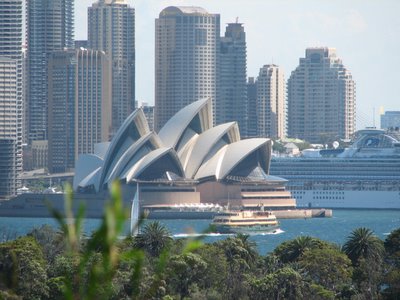
Above: Photo showing the view of Sydney CBD from Taronga Zoo.
Taronga Zoological Park
Above: Photo of the entrance to Taronga Zoological Park, Sydney.
We are in Sydney visiting our son and daughter in law. Today we went to the Taronga Zoological Park. it has been almost six years since our last visit. There have been many changes made since then. It was quite obvious that big attempts have been made to improve both the animal displays and the overall facilities for humans.
While our prime objective was to view the animal displays, I cannot help being on the lookout for native Australian birds flying around free. Many of the enclosure’s feed trays provide a free meal for some of our native species. This Noisy Miner didn’t need to get into one of the cages. It just fed from a bottlebrush flower poking though one of the aviaries.

Above: Photo of Noisy Miner feeding on a bottlebrush (Callistemon sp)
As we were going along we observed a Laughing Kookaburra sitting quietly on the branch of a tree near the path. This is one species I have been trying to photograph since buying my new digital camera. This was one species I didn’t expect to see or photograph today.
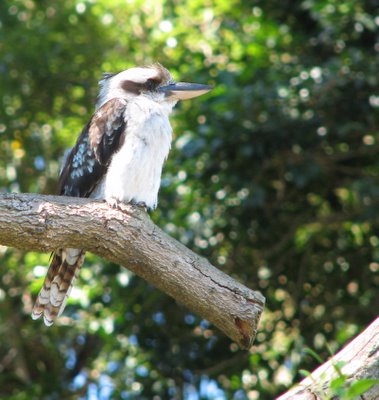
Above: Photo of a Laughing Kookaburra in the grounds of Taronga Zoo, Sydney.
One of the highlights of visiting Taronga Zoo is the show put on by a range of Australian birds under the direction of several keepers. It is awesome to observe a Wedge Tailed Eagle gliding about a metre or two overhead as it headed down towards the keeper. We also saw a beautiful White-Bellied Sea-Eagle. 
Above: Photo of a White-Bellied Sea-Eagle
Zebra Finch
Above: Photo of a Zebra Finch
We went to visit Pangarinda Arboretum again today. This is a large plantation of Australian native plants just east of Wellington, South Australia. This is about half an hour from Murray Bridge, or just over an hour from Adelaide.
As is my custom these days my attention was divided between watching birds, making a list of birds I see for my database, photographing any birds I see and photographing the many beautiful flowers in this arboretum. Summer is fast coming to an end here in the Murraylands region of South Australia so there are not too many native Australian plants in flower at present, but still enough for me to get some very nice shots.

The birding was also quite good with 23 species recorded. The best sighting of the day was that of Zebra Finches. I have recorded this species here before, but not in such good numbers. They almost outnumbered the commonest bird in the garden, the New Holland Honeyeater. A number of finches, including an obliging male, came close enough for me to get some lovely photos.






